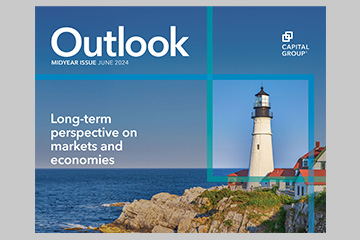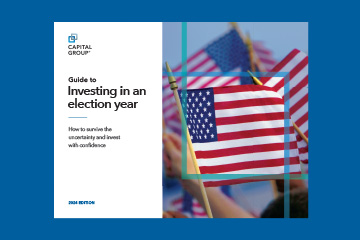Global Equities
Global Equities
As we embark on a new year, the challenges ahead are well defined. Interest rates are elevated. Elections are upcoming. And U.S. stock indexes are near all-time highs. Are these events setting the stage for a disappointing pullback or another bull run?
In this wide-ranging Q&A, Rob Lovelace, principal investment officer of New Perspective Fund®, offers his view on where markets are headed, the rise of the Magnificent Seven, the interest rate environment and select investment themes driving his portfolio decisions.
What’s your market outlook for 2024?
Looking at today’s market, there is some similarity between the Nifty 50 period of the 1960s and 1970s, the technology bubble of the late 1990s, and the years leading up to the financial crisis that occurred between 2008 and 2009. When you examine the current period, it is characterized by the remarkable gains of the Magnificent Seven (Alphabet, Amazon, Apple, Meta, Microsoft, Nvidia and Tesla.) Investors are rightly concerned about the valuations of those companies and the narrowness of the market gains. In that group, there are clear similarities to the Nifty 50 (IBM, Sears, General Electric, among others) and worries about market concentration at that time.
None of those periods are exactly the same as today, but they do rhyme in certain ways. If you recall those three periods, in all three cases, there was a market decline associated with an economic event, a recession. They were also long market cycles. They were not like the sharp COVID downturn or the 1987 market crash. They were multi-year events. If there is some similarity today, then we should expect to see significant volatility in 2024. This is also an election year, and election years are often volatile. So, as a portfolio manager, I am prepared for that. And I am prepared for what typically comes next, which is a sustained period of recovery.

Capital Ideas™ webinars
Insights for long-term success
Do you think the Magnificent Seven are overvalued?
It’s more like a warning signal. Any time you get a sector or a concentrated group of stocks that stand so far apart from the rest, you need to pay attention because it’s usually a warning signal. Whether it was the financial sector before the global financial crisis, or internet stocks in the late ‘90s, or oil stocks at various times, the market is telling you something you need to know.
These seven stocks now represent nearly 30% of the S&P 500 Index. That should get your attention. We’ve taken the time to go back and do research on the Nifty 50 — which, it turns out, was not 50 stocks but more like 40-something. That research revealed some important lessons. As a group, those 40-ish stocks were overvalued. As a group, they went up a lot, and then they came down a lot. But about half of them were worth holding through the whole event because they recovered on the other side of it.
The Magnificent Seven and Nifty 50: We’ve seen this movie before

Sources: Capital Group, RIMES, S&P Capital IQ, Standard & Poor's. The analysis includes 41 companies among the list of "Nifty Fifty" companies for which market capitalization data exists continuously from 1964 to 1974, using both RIMES and S&P Capital IQ. The Nifty Fifty was a list of U.S. companies identified by Morgan Guaranty Trust whose valuation multiples traded at levels well above the S&P 500 given their perceived growth prospects at the time. The "Magnificent Seven" refers to the seven largest contributors to the S&P 500 in 2023. Company examples shown here for the Nifty 50 represent some of the largest companies in the group from various industries and are for illustrative purposes only. As of December 31, 2023.
It isn’t as easy as saying, “This group of stocks is overvalued; therefore, we shouldn’t own them.” I would say, ignore them to your peril. But I would also say, like the Nifty 50, you don't just buy them as a group, because they are not a real group. They are not an industry. They are not driven by the same factors.
What's driving Tesla is different from what's driving Netflix or Meta or Microsoft. The Magnificent Seven is a phenomenon. And what the phenomenon tells you is that there is risk in the market. But it doesn't tell you whether you should buy, hold or sell. This is where the benefit of active management comes in. The passive investor gets the entire group. Active investors get to pick and choose based on the fundamental prospects for each company. That’s how I look at it.
Will higher interest rates hurt the stock market?
People tend to assume that higher rates are bad for stocks and lower rates are good. But it really depends on the company and the sector, how it plays out, and how long it lasts. So that rule of thumb is weak. What we've seen so far is that the markets have been strong not because of interest rates going up or down, but because the economy hasn't rolled over. The assumption was that higher rates would force us into a recession, which would be bad for corporate earnings, which is ultimately what the market cares about. Instead, we've seen stronger-than-expected earnings in many different companies and sectors.
Interest rate hikes haven’t necessarily been bad for stocks

Sources: Capital Group, Federal Reserve, Standard & Poor's. S&P total returns during prior hiking cycles are based on the total return for the S&P 500 Index between the date of the first increase in the target federal funds rate and the date of the final increase in the target federal funds rate. The federal funds rate shown is the average monthly effective federal funds rate, which reflects the volume-weighted median interest rate that depository institutions charge each other for overnight loans of funds. As of December 31, 2023. Past results are not predictive of results in future periods.
As it turns out, the Federal Reserve and other central banks raised interest rates aggressively, and the market didn’t care as much as we thought it would. This period provides a good reminder to people that higher rates do not always equal lower markets. And lower rates do not always equal higher markets.
Keep in mind, we're in a slightly different environment now. With rates as high as they are, people assume they will go back down. That's all anyone is talking about. Everyone has convinced themselves that rates will go down again, and it’s just a matter of when and how much. That’s another reason I think the risk is to the downside. The risk is that rates stay higher for longer, and that’s yet another reason why I think the market has more downside risk in this current construct.
How concerned are you about election year volatility?
Election years are always volatile. Markets want certainty and, in the last few election cycles, the issue that has been challenging is not which party won, but the fact that nobody won convincingly. This time around, I think we could have a similar set of circumstances, and no one will be satisfied no matter the outcome. There may be court challenges. There could be protests. And that’s never good for markets. So we’ll probably have some market strength at times during the campaign season, and then as we get closer to the election, people will get nervous.
Then usually toward the end of the year, as whoever won gets ready for the inauguration and cabinet appointments are announced, people will say, "Oh, maybe I don't like the candidate, but the cabinet looks good." And that will begin to build a base from which the markets have a chance to come back.
Do election issues ever factor into your investment decisions?
I typically look beyond the election cycle and aim for an average holding period in my portfolios of roughly eight years — essentially two presidential terms. That said, sometimes election uncertainty can provide attractive entry points for investing in companies that get caught up in a heated political debate.
For instance, this often happens in the pharmaceutical industry when politicians take aim at high drug prices. When everyone worries that a new government policy is going to hurt a sector, that concern is often overblown. High-quality companies sometimes get caught in political crosshairs, which can create a buying opportunity. I keep an eye out for those types of events during an election campaign.
Market volatility in election years can present investment opportunities

Sources: Capital Group, Refinitiv Datastream, Standard & Poor’s. Includes all elections since 1992, as of December 31, 2023. October 31 used as a proxy for each election date in the calculations of returns one year before and after an election. For example, the first year measured before the 1992 election is October 31, 1991-October 31, 1992, and the last year measured after the 2020 election is October 31, 2020-October 31, 2021. Past results are not predictive of results in future periods.
What investment themes interest you today?
The number one theme on my mind as an investor is related to health care. Within the sector, there are two big developments. One is the explosion in popularity of GLP-1 drugs, such as Ozempic and Wegovy, that help with weight management and appetite suppression. The other is personalized medicine, or the creation of medicines tailored to the individual through DNA mapping.
Both areas are incredibly exciting and have the potential to be truly game changing. We are also looking at how these developments could impact other companies, positively or negatively. For instance, the research shows that these drugs not only help with appetite suppression, but they can also affect behaviors such as alcohol consumption, gambling and other habits involving impulse control.
As investors, we need to think about what that means for alcoholic beverage makers, gaming stocks, food companies and a wide variety of other companies. It may take a long time for these impacts to materialize, but the stocks will move before that, so it’s something we are spending a lot of time researching today. These ripple effects could wind up being important. There will always be winners, and there will always be companies that get disrupted. We, as long-term investors, must consider a multitude of outcomes.
Anything in addition to health care?
The rise of artificial intelligence (AI) is a theme that we all need to understand. It's less clear to me than in the health care sector who are the immediate beneficiaries. One always thinks of certain computer chip companies, but even there I'm not sure it's going to be sustained at the windfall levels we see now. I think we're all coming around to the fact that having an AI product that's 90% accurate is fun and helpful, but it doesn't present the existential threat to jobs that some had feared.
As we saw with the gig economy, I don’t think AI will eliminate many jobs, it will just shift them around and impact employees in different ways that may have implications for salaries and benefits. I believe AI is something that will affect every company, but in ways that may be less predictable than many people think. So it’s something we should watch closely, and we need to see how it plays out across all sectors, not just the tech sector.
What's your long-term stock market outlook?
Well, when it comes to the long-term compounding of the stock market, the rule of thumb that I learned in school was that 7% was the average. To be clear, that wasn’t a guarantee, and markets moved around as much then as do now. Probably more important, it wasn't adjusted for inflation. So, when I was early in my career, half of the expected return was just inflation, and half or less of it was real. So back in the day, a lot of us thought that as inflation came down, the total return on the market also would come down.
What's fascinating is, not only did it not come down, it went up. If you look at the long-term numbers now, even with the bear market in 2022, the compounding of the U.S. stock market since the 1970s was north of 9%. The incredible thing about the way the stock market works is, as long as you've got companies doing amazing things, enabling them to grow and create new products, it's a flywheel. It's a geometric process, not an arithmetic process, in terms of the benefits to investors.
We've talked about what's happening in health care, technology, AI and economic growth generally. And even if overall economic growth rates are muted going forward, there are a lot of good things happening with companies in the stock market. So my long-term view remains positive. I’m sticking with 7%.
S&P 500 Index is a market capitalization-weighted index based on the results of approximately 500 widely held common stocks.
The S&P 500 Index is a product of S&P Dow Jones Indices LLC and/or its affiliates and has been licensed for use by Capital Group. Copyright © 2024 S&P Dow Jones Indices LLC, a division of S&P Global, and/or its affiliates. All rights reserved. Redistribution or reproduction in whole or in part is prohibited without written permission of S&P Dow Jones Indices LLC.

Get the 2024 Midyear Outlook report

Get the guide
RELATED INSIGHTS
-
-
Economic Indicators
-
Markets & Economy
Never miss an insight
The Capital Ideas newsletter delivers weekly insights straight to your inbox.
 Rob Lovelace
Rob Lovelace